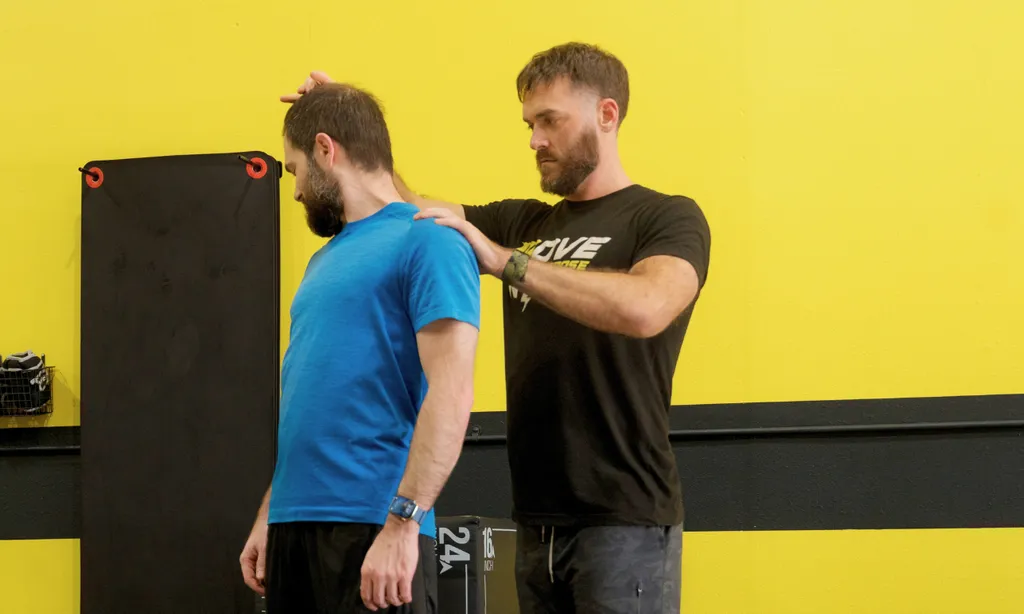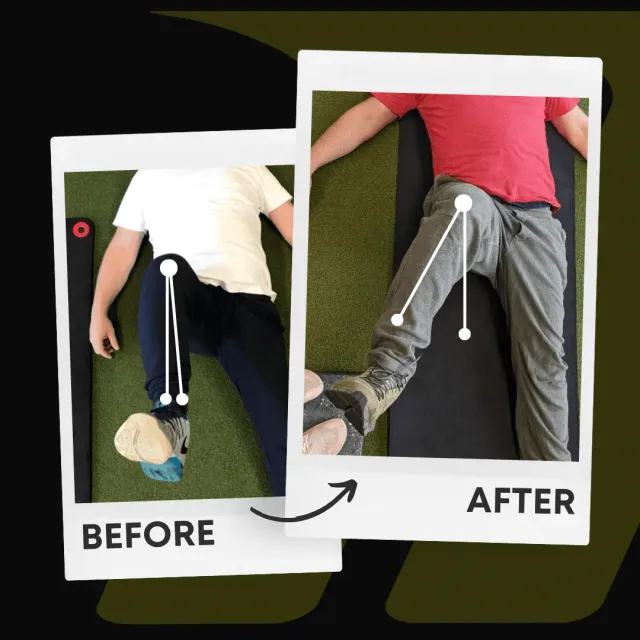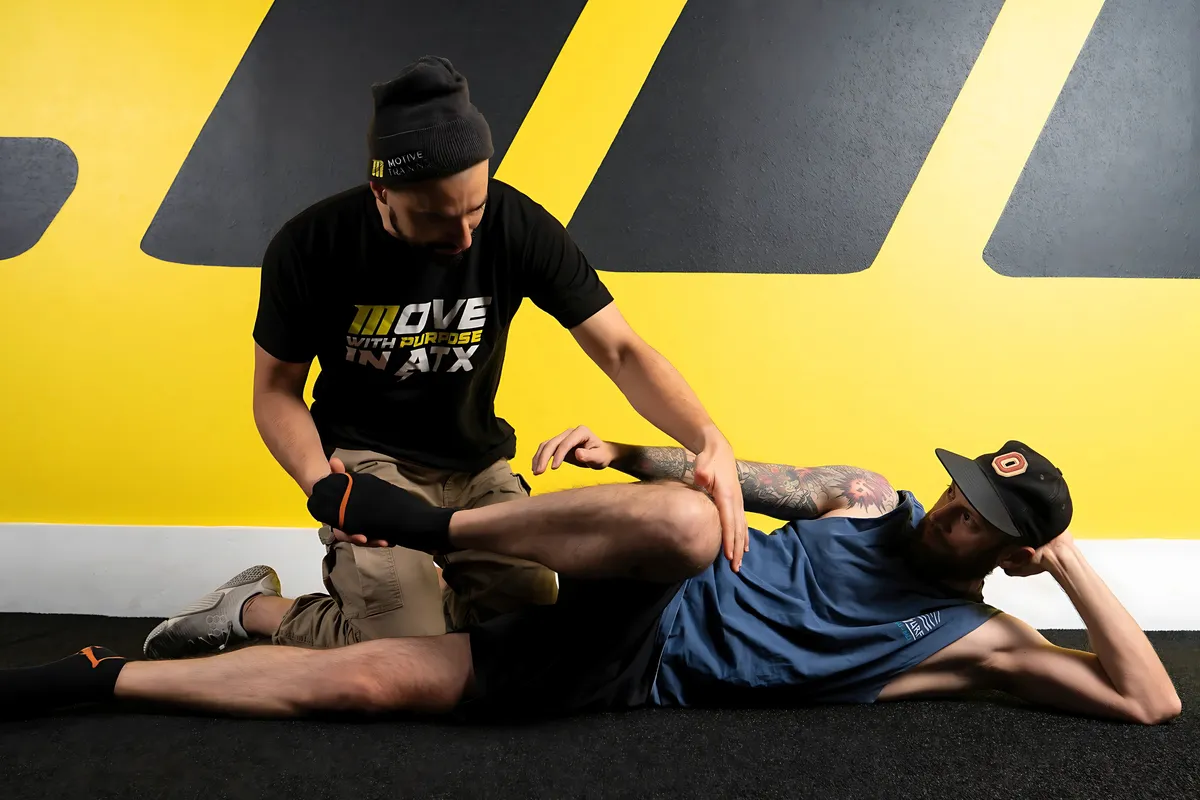Two Areas That Make The Functional Range Assessment Unique
January 1, 2025 | Functional Range Assessment

Are you ready to learn how to Move With Purpose from the comfort of your own home? With our Mobility Blueprints or Online KINSTRETCH Membership, you’ll gain the tools and guidance to stretch, mobilize, and strengthen your joints for lasting results. Our expert-designed programs focus on improving joint health, reducing pain, and enhancing mobility so you can move and feel better daily. Invest in your movement today—we guarantee it will be worth it!
When it comes to fitness and mobility, most gyms and trainers focus on big, obvious areas like the shoulders, hips, and core. While these regions are undoubtedly important, neglecting smaller but equally crucial areas such as the neck and toes can have significant consequences. For instance, neglecting the neck can lead to chronic pain, poor posture, and even compensations that affect the upper back and shoulders. Similarly, overlooking the toes can disrupt the entire kinetic chain, leading to knee, hip, and spine issues. Dysfunction in these areas often goes unnoticed until it manifests as pain or injury. This oversight leaves a gap in most training programs that the Functional Range Assessment (FRA) is uniquely equipped to fill.
For instance, a personal trainer could use the FRA to identify a client’s neck and toe limitations, then design a customized exercise plan to address these issues. Ignoring the neck can lead to chronic pain, poor posture, and even compensations that affect the upper back and shoulders. Similarly, overlooking the toes can disrupt the entire kinetic chain, leading to knee, hip, and spine issues. By addressing these often-ignored areas, we can create more balanced, resilient movement patterns and prevent larger problems from arising down the road. The the FRA’s precision makes it possible to bring these neglected areas back into focus, creating a more comprehensive approach to joint health and mobility.
What Is The Functional Range Assessment?
The Functional Range Assessment (FRA) is an advanced system designed to evaluate joint health and mobility with unparalleled precision. Unlike traditional assessments, the FRA targets the specific active ranges of motion your joints can control, focusing on their individual capacity and function. This method takes a deep dive into the health of the soft tissues, joint capsules, and motor control. By applying the FRA, our personal trainers can identify limitations, asymmetries, and dysfunctions that may contribute to pain, poor posture, and reduced performance.
Introduction To The Functional Range Assessment
A Functional Range Assessment (FRA) is a comprehensive evaluation designed to measure a patient’s range of motion, strength, and flexibility. This assessment is crucial for healthcare professionals to pinpoint any limitations or abnormalities in a patient’s movement patterns. When it comes to neck pain, the FRA can be particularly insightful, helping to identify restrictions in the cervical spine, shoulder, or upper back that may be contributing to the discomfort.
During the FRA, the healthcare professional will assess both the active and passive range of motion, strength, and flexibility in the neck and surrounding areas. This involves a series of movements such as flexion, extension, rotation, and lateral flexion, along with strength testing and palpation of the soft tissues. By thoroughly examining these aspects, our personal trainers can uncover specific areas of limitation or abnormality.
The ultimate goal of a Functional Range Assessment is to identify the underlying causes of neck pain. By doing so, healthcare professionals can develop a targeted treatment plan that addresses these root issues, promoting optimal function and mobility. This proactive approach not only alleviates current symptoms but also helps prevent future occurrences of neck pain, empowering individuals to take control of their joint health.
Assessing Neck Pain With The FRA
Neck pain is one of the most common complaints, often linked to poor posture, long periods of inactivity, and even stress. Similarly, toe pain can be caused by a variety of factors, including poor footwear, overuse, or underlying health conditions. Functional Range Conditioning (FRC), the methodology behind the FRA, offers a precise way to assess and address these issues. During an FRA, the neck is analyzed for both active and passive ranges of motion. Our personal trainers evaluate cervical flexion, extension, lateral flexion, and rotation. They also identify compensatory patterns, such as excessive upper back movement during neck rotation.
In addition to these objective measures, a subjective assessment is conducted to gather detailed information about the patient’s symptoms and medical history related to neck pain.
The key to fixing neck pain isn’t just stretching; it’s improving the ability of the neck’s muscles and joints to control their ranges. Controlled Articular Rotations (CARs), a foundational FRC exercise, are used to isolate and strengthen specific ranges. For example, if a client demonstrates weakness in cervical extension, our mobility coaches may prescribe segmental extension drills or isometric holds to build strength in those ranges. This approach alleviates symptoms and builds long-term resilience by addressing the root cause.
Here’s a video of Andres demonstrating a neck controlled articular rotation (CARs). Notice the full range of motion and lack of compensation.
Addressing Toe Pain With The FRA
Toe pain often goes unnoticed until it becomes severe enough to interfere with daily activities. The FRA process uniquely examines the toes by isolating their movement and assessing the health of each toe joint and its contribution to overall foot health. Dysfunction in the big toe—essential for balance and gait—can lead to compensations that stress the knees, hips, and even the spine.
During a toe assessment, our certified personal trainers will evaluate the big toe’s ability to flex, extend, abduct, and adduct. Common findings include limited dorsiflexion, poor intrinsic muscle strength, and compensatory movement patterns. One targeted intervention involves Toe CARs, an FRC technique that isolates toe movement to improve joint independence and strength. For those with severe limitations, isometric contractions within end-range positions can be implemented to build foundational strength before progressing to dynamic movements.
Here is Andres demonstrating toe CARs.
Why The FRA Stands Out
What sets the FRA apart is its individualized approach. This includes evaluating factors such as head shape, which can provide insights into potential health issues related to muscle strength and control. Unlike general physical exams, which might focus on symptoms and prescribe rest or pain medications, the FRA digs deeper to identify the root causes of dysfunction. It combines subjective assessments, like a patient’s experience of pain or stiffness, with objective measurements of joint capacity. This thorough approach allows our mobility coaches to create specific, actionable plans to improve joint health and prevent future issues.
Beyond The Neck And Toes: A Head To Toe Assessment
The FRA system’s ability to conduct a head-to-toe assessment ensures that unexpected findings don’t go unnoticed. For example, poor neck mobility might correlate with respiratory dysfunction due to limited rib cage expansion, while a stiff big toe could contribute to compensatory patterns affecting the knees or hips. By addressing these connections, the FRA doesn’t just treat the symptom—it improves the entire kinetic chain.
Preventing Neck Pain And Promoting Healthy Neck Muscles
Preventing neck pain and promoting healthy neck muscles involves a multifaceted approach that includes good posture, regular exercise, and effective stress management. Here are some practical tips to help you maintain a pain-free neck and robust neck muscles:
- Maintain Good Posture: Whether sitting or standing, ensure your posture is aligned. Avoid slouching or leaning forward, as these habits can strain your neck muscles over time.
- Exercise Regularly: Engage in exercises that strengthen the neck and shoulder muscles. Activities like yoga or Pilates are excellent for building muscle strength and flexibility, which can help prevent neck pain.
- Manage Stress: Incorporate stress-reducing techniques into your daily routine. Practices such as meditation or deep breathing can help manage stress levels, reducing tension in the neck muscles.
- Take Regular Breaks: If your job involves prolonged sitting or standing, make it a point to take regular breaks. Use this time to stretch and move around, which can help prevent stiffness and discomfort in the neck.
By integrating these habits into your daily life, you can significantly reduce the risk of neck pain and promote the health of your neck muscles. Consistently practicing these tips will contribute to long-term neck health and overall well-being.
The FRA in Practice: Physical Examination
At Motive Training, our approach to Functional Range Assessment (FRA) is more than just evaluating movement; it’s about understanding the entire picture of your health and performance. As part of our thorough physical examination, our trainers may also note factors such as unexplained weight loss, fatigue, or other systemic signs that could point to underlying conditions. These details are not overlooked—they are critical in providing a holistic view of your physical well-being.
The FRA allows us to move beyond surface-level fixes, offering actionable insights into your body’s needs and limitations. We can tailor strategies to improve joint health, control, and strength by identifying active joint ranges and assessing areas where function may be compromised. This isn’t just about getting you moving; it’s about building stronger, more functional movement patterns that can handle the demands of your life—whether it’s recovering from an injury, enhancing athletic performance, or simply staying active and pain-free.
At Motive Training, our mission is to ensure that every client walks away with the tools and understanding necessary to sustain their progress for the long term. With the FRA as a cornerstone of our approach, we don’t just address the symptoms of discomfort or poor mobility; we target the root cause, empowering you to move with purpose and confidence.
Written by

Motive Training Staff
We’ll teach you how to move with purpose so you can lead a healthy, strong, and pain-free life. Our headquarters are in Austin, TX, but you can work with us online by signing up for KINSTRETCH Online or digging deep into one of our Motive Mobility Blueprints.

